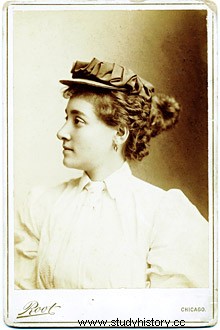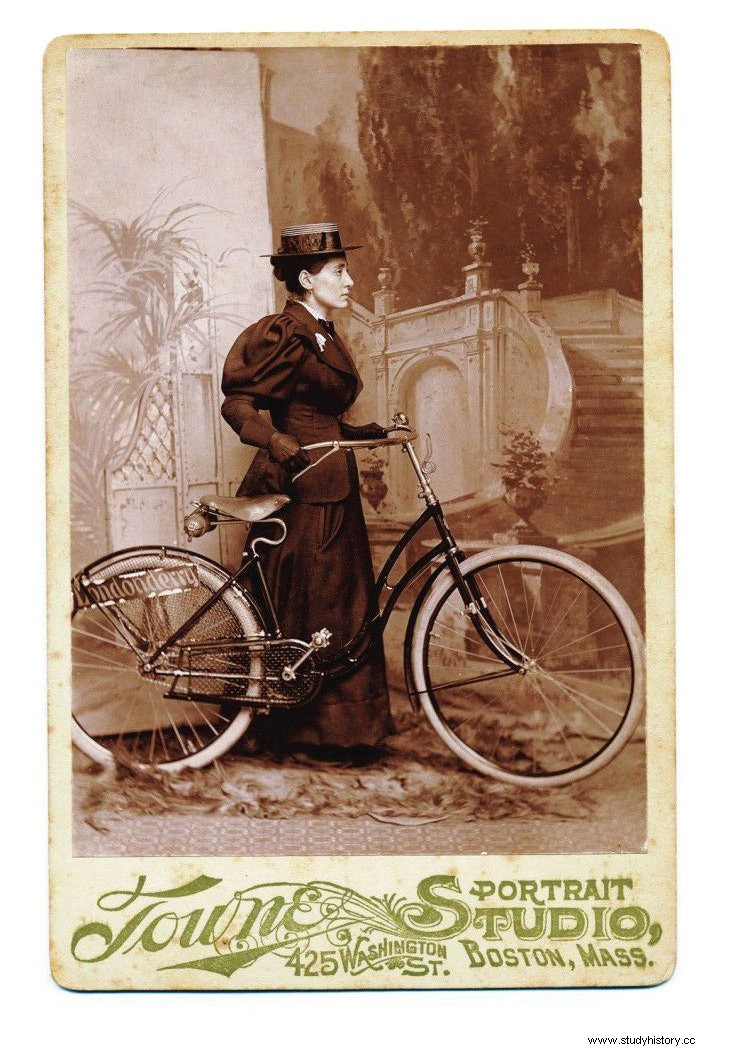Annie Cohen Kopchovsky, also known as Annie Londonderry (1870–1947), was the first woman to circumnavigate the globe by bicycle. The feat took him fifteen months.
Young wife and mother

Daughter of Beatrice and Levi Cohen, Annie Cohen was born in 1870, probably in Riga, Latvia, where her family originated. Her parents emigrated to Boston in 1875 with their three children, Annie, her older sister and brother, Sarah and Bennett. Then four or five years old, Annie becomes an American citizen. Two other children, Jacob and Rosa, later join the family.
We know very little about Annie's childhood. When she was sixteen or seventeen, her father and then her mother died two months apart, leaving behind five orphans. Sarah, the eldest, already married, has left home and Bennett and Annie find themselves in charge of their younger brother and sister. The two marry quickly, and their respective spouses settle down with them. At eighteen, Annie married Simon Kopchovsky, nicknamed Max, a peddler. They will have three children in four years:Bertha Malkie, nicknamed Mollie, Libbie and Simon. Commercial, Annie sells advertising space for several daily newspapers in Boston.
A bet?
The story goes that Annie Cohen Kopchovsky embarked on the crazy adventure of a world tour by bicycle, unthinkable for a woman at the time, following a bet. In 1894, two wealthy men in Boston would have taken a bet, at $20,000 against $10,000 – very substantial sums – that no woman could complete a round-the-world bicycle tour in fifteen months. At stake:$5,000 for the adventurer in question. Annie, who didn't have a penny in her pocket at the time, would have taken up the challenge.
The existence of this bet is however questioned; the names of the two bettors were never mentioned. The story, on the other hand, could have been fictionalized to draw curiosity around Annie's expedition. Publicity around this world tour could also have benefited the Pope Manufacturing Company, producer of bicycles and supplier of a model used by Annie; seven years earlier, the company had already supplied the bicycle on which Thomas Stevens had become the first man to cycle around the world.
Women on bikes
For a woman, the adventure is societal almost as much as physical. Appearing in 1817, the bicycle gradually began to appeal to women – and first well-to-do women – from the 1860s. improper for a woman to ride a bicycle. Doctors are alarmed that cycling can harm women's fertility and cause them all kinds of health problems.
Despite this reluctance, the use is spreading and more and more women are taking advantage of the new freedom of movement and independence offered by the bicycle, and encouraged by the manufacturers. Even the outfits are changing, to offer cyclists more mobility and freedom of movement. The trend, at the end of the 19 e century, was such that the American suffragist activist Susan B. Anthony would go so far as to declare in 1896 that "the bicycle has done more for the emancipation of women than anything in the world. I persist and rejoice every time I see a woman on a bicycle."
The great departure
Despite this new enthusiasm, Annie Cohen Kopchovsky is an unlikely candidate for this feat:she has simply never ridden a bike. At a time when women's place is considered to be in the home, she is also a wife and the mother of three young children. None of these obstacles discouraged Annie, however:she prepared her trip, and found a sponsor with the Londonderry Lithia Spring Water Company , notably by accepting for the duration of the exploit to bear the name of "Annie Londonderry".
On June 25, 1894, dressed in a long skirt, without money and provided, for all her luggage, with a few spare clothes and a revolver with a mother-of-pearl handle, Annie left Boston on a Columbia woman's bicycle; she is cheered on by a crowd of around 500 who witness the start of her journey. After New York, it heads west to reach Chicago and then San Francisco.

First disappointments
On her way to Chicago, Annie Londonderry follows routes indicated in tourist guides, with precise directions as well as places to stop to eat and sleep; she thus manages to cover between 13 and 16 kilometers per day – a distance to be compared to the infrastructures and equipment of the time. Arrived in Chicago, however, she who is of a small build has already lost nine kilos and discouragement awaits her. Moreover, the approaching winter makes it too dangerous to cross the mountains towards the west, towards San Francisco, and Annie, instead of letting herself down, decides to change her route; going back, she returns to New York to board for France.
On the way, Annie meets the company Sterling Cycle Works , which sponsors his trip and offers him an Expert E Light Roadster model, without brakes but much lighter and easier to handle than his initial bike. Annie also swaps her awkward long skirt for bloomers, then for a masculine riding costume. Thus equipped, it can continue its journey in better conditions. In November, she embarks on Le Touraine towards Le Havre; there are then only eleven months left of the fifteen initially planned to complete his world tour.
Around the world by bike
In Le Havre, Annie Londonderry faces new difficulties:her bike is confiscated by customs and she has to face the hostility of the press concerning her physical appearance and clothing. She manages to get out of this situation and reaches Marseille in two weeks, despite the difficult weather and a bandaged foot, wedged on her handlebars while she rides, due to an injury. From Marseille, Annie takes the boat to Alexandria then continues the stages by traveling by boat and bicycle.
After Egypt, Annie passed through Yemen, Sri Lanka, Singapore, Saigon, Hong Kong, Nagasaki and Kobe in particular before returning to the boat in March 1895, heading for San Francisco. From there, it goes towards Los Angeles and crosses Arizona and New Mexico. In Nebraska, due to the muddy roads, she does some stages by train. Finally, she reached the end of her world tour, in Chicago, on September 12, 1895. She was two weeks ahead of her fifteen-month goal, and collected her prize.
Life after fame
In October 1895, Annie Londonderry published her travelogue in New York World which titles it “the Most Extraordinary Journey Ever Undertaken by a Woman” ("the most extraordinary journey ever made by a woman"). She gives lectures and writes about her adventures, not hesitating, as an excellent salesperson and storyteller, to embellish the facts or even outright invent anecdotes to increase her popularity; she had already undertaken it during her trip, sometimes presenting herself as a rich orphan, as a medical student or as the niece of a senator. Back in the United States, Annie invents anecdotes around a tiger hunt in India or a stay in prison in Japan. She also performs cycling demonstrations and sells photos of herself, memorabilia and autographs.
For a time, she was highlighted by feminist movements, for her adventure demonstrating that women are capable of as much as men. Despite her talent as a storyteller, Annie Cohen Kopchovsky's feat eventually fell into oblivion and her popularity faded. She died in oblivion and destitution in 1947.
